No CrossRef data available.
Article contents
Molecular Epidemiology and Legionnaire's Disease
Published online by Cambridge University Press: 21 June 2016
Abstract
An abstract is not available for this content so a preview has been provided. As you have access to this content, a full PDF is available via the ‘Save PDF’ action button.

- Type
- Departments
- Information
- Copyright
- Copyright © The Society for Healthcare Epidemiology of America 1993
References
1.
Redd, SC, Cohen, ML. Legionella in water: what should be done?
JAMA
1987;257:1221–1222.CrossRefGoogle Scholar
2.
Stout, JE, Yu, VL, Best, MG. Ecology of Legionella pneumophila within water distribution systems. Appl Environ Microbial
1985;49:221–228.CrossRefGoogle ScholarPubMed
3.
Van Ketel, RJ, Schegget, JS, Zanan, HC. Molecular epidemiology of Legionella pneumophila serogroup 1. J Clin Microbiol
1984;20:362–364.CrossRefGoogle ScholarPubMed
4.
Pedro-Botet, ML, Sabrià-Leal, M, Espinosa, LI, Condom, MJ, Carrasco, I, Foz, M. Utilidad de los marcadores epidemiologicos moleculares en el estudio de unbrote epidemico de enfermedad dellegionario de origen nosocomial. Med Clin (Barc)
1992; 99:761–765.Google Scholar
5.
Pfaller, MA. Typing methods for epidemiologic investigation. In: Ballows, , ed. Manual of Clinical Microbiology. Washington, DC: American Society for Microbiology; 1991: 171–182.Google Scholar
6.
Pfaller, M, Hollis, R, Johnson, R, et al. The application of molecular and inmunoltechniques to study the epidemiology of Legionella pneumophila serogroup 1. Diagn Microbiol Infect Dis
1989;12:295–302.CrossRefGoogle Scholar
7.
Addis, D, Davis, J, Laventure, M, Hutchinson, M, McKinney, R. Community acquired Legionnaires disease associated with a cooling tower: evidence for longer distance transport of L pneumophila
. Am Epidemiol.
1989;130:557–558.CrossRefGoogle Scholar


